Perched in a tree jutting from a cliff hundreds of feet above fast-moving Mountain Home Creek I would have welcomed a calming cup of tea.
SAN GORGONIO WILDERNESS, Calif. – A few miles from Angeles Oaks Calif., there is a trailhead on Hwy. 38 leading to Mountain Home Flats, an early settler’s homestead located in the San Gorgonio Wilderness of San Bernardino County.
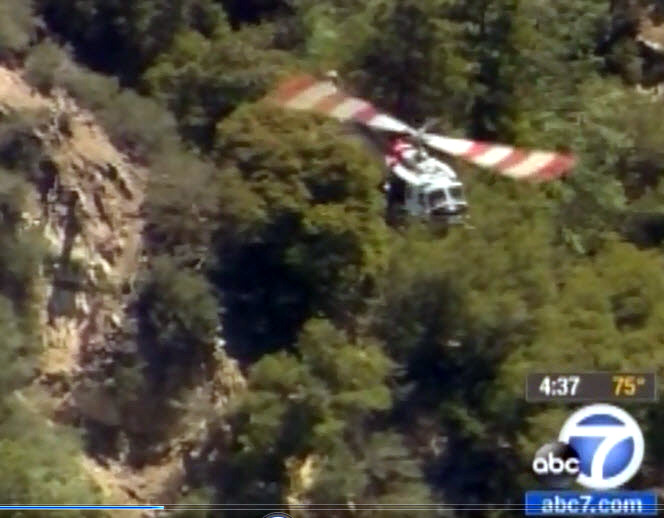
San Bernardino Mountain rises 10,649 ft., high above the flats which are about 7,800 ft. up the north side of the mountain. Below is the East Fork of Mountain Home Creek. There is a waterfall a short distance from the fire circle and spectacular vistas. On a clear day from the peak looking East you can see the snow-covered Sierra Nevada mountains and from the West face the azure Pacific.
Calling this area “flat” is a misstatement. The difficult vertical climb rises more than 4,600 ft. in a distance of 16.5 miles from the village of Angeles Oaks. The 60-mile range, formed 11 million years ago by the San Andreas Fault, boasts the highest mountain in Southern California (San Gorgonio Mountain at 11,499 ft.).
My companions Sarah Baisley and Chris Harz and their two big white German shepherds, joined me on the hike, returning to a trail we had last walked a dozen years ago.
Adventures have happy endings – mishaps, not so much. In this tale my survival was 5 parts luck and 10 parts scouting and firefighting experience. I’m happy I could write the ending.
We set out early May 26, arriving at the trailhead before noon. The hike to our base camp was much more difficult than in past years due to fallen timber. Giant Coulter, Jeffery and Ponderosa Pines dominate this region. These gray-green trees grow to 80 feet tall. Some blocking the trail were four foot in diameter. The pine cone of the Coulter weighs as much as 12 pounds and measure 18 inches. Foresters call them “widowmakers.”
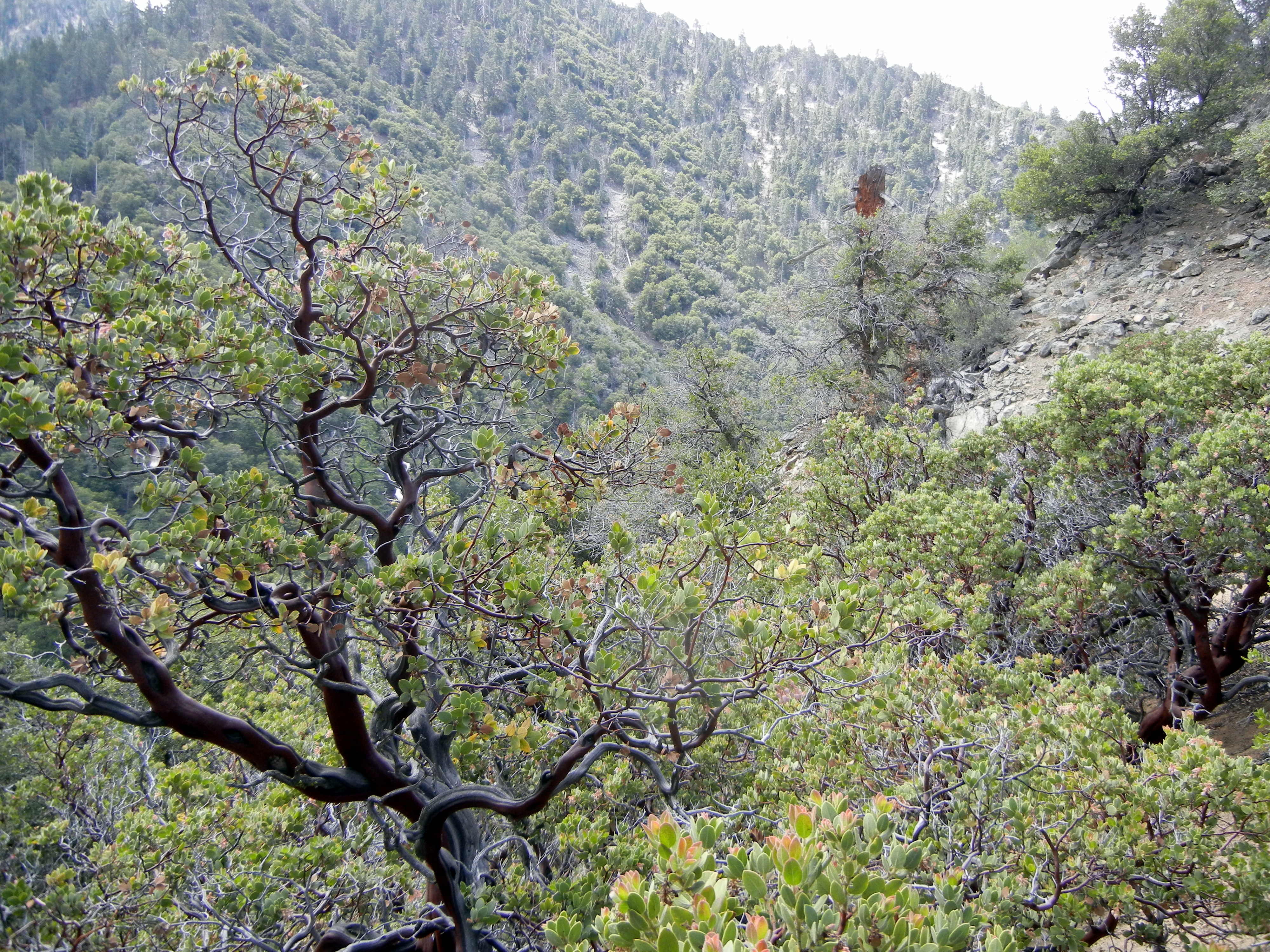
The temperature was in the 80s. I had last hiked the trail in 2002 and not many had walked it since. At one point I led the group up a steep incline only to retreat. My friend Patrick Graham and his son were ahead of us, returning from their early-morning trail blazing efforts. They saw us and put us on the right path.
Graham said the trail ahead was “bad, very bad.”
As early evening approached we set up a base camp on a ridge opposite Mountain Home Flats high above the creek. Everyone was thirsty, including the dogs, so I set out with Sarah for water. Ahead was a narrow ledge and a stretch of along the face of the cliff that my daughter Tessa calls the “goat trail above the abyss.”
The trail from the ridge was in bad repair. I decided to rig safety line. It took an hour to secure the line, inching along the rock face as scree tumbled below. It was another hour to descend to Mountain Home Creek. California was undergoing its worst drought in a century but there was good flow in the creek. I used the Katadyn filter to insure the water was safe. Eight canteens and water bottles later, when I started back from the creek it was nearly dark. At the foot of the ridge stumbled. While I knew the trail quite well, the climb had been much more tiring than I remember. My headlamp cast uncertain light and I began to slip and fall every 10 yards, cutting and scraping my calves until they bled.
It was then I realized I would have to spend an uncomfortable night under a tree. Carrying a pack of water in the dark along the face of a cliff seemed too risky. I bed down on pine boughs near a big log.
Deciding to spend a 60-degree night under the stars saved my life.
I did not know it at the time, but Sarah had already fallen down the scree while returning to base camp. See too was forced to spend the night hugging a Manzanita bush, exposed to the night air.
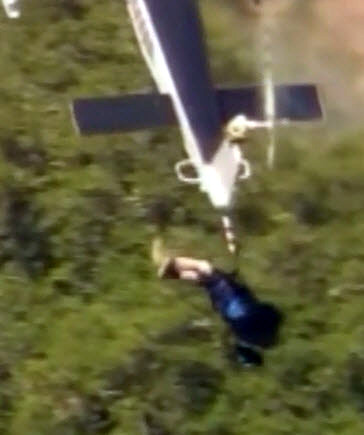
At dawn as soon as I could see the trail I set out. I was returning with gallons of water in my pack, facing the cliff, inching my way along when suddenly the narrow ledge gave way. I had looped the safety line around my right hand as I progressed and now found myself suspended about 20 feet below the ledge by that hand… boy did that hurt…. my fingers quickly turned purple under my 350 pound weight but I was able to hang there long enough to kick into the crumbling rock with my left boot. In time I had a rock climbers three-point hand and foot hold.
I let go of the line. My right hand was swollen, numb and useless. I steadied myself with my left and crab walked across the face of the cliff. I was 60 feet below the ledge. I could not see how far it was to the sloping scree and safety far to my left. I knew it would be a long stretch of sheer, near vertical rock to cross. I started out, kicking toe holds with my steel-toe boots as I made my way.
Progress was slow. I had moved about 20 feet across the face of the rock when I noticed a dark shadow to my left. It was from a tree anchored below me. I was tiring. I looked down. The 400 fall would send me into the sharp sloping rocks. Without a climbing helmet I would then likely tumble unconscious into the fast-moving creek below.
You can imagine how happy I was to see that shadow led to a a wiry little tree. It was a broad leaf with smooth bark and a trunk diameter between six and eight inches. I maneuvered above it, slid face first slowly down the rock and straddled it between my legs with my back to the cliff. I rested a while, wrapped my hand and took stock of the situation. Secure from a fall I started with an inventory. My glasses and hearing aids were still in place. In my fanny pack I had a radio and water, a flashlight and a Leatherman tool, a bandanna, compass and hat. My walking stick had fallen within arm’s reach.
Chris Harz awoke that morning counting on me to help pull Sarah out of her predicament.
Earlier I had waved and greeted him at a distance before setting off along the ledge and he acknowledged with a shout. Now I was doing the shouting, explaining that I had fallen and needed a chopper.
Chris had tried the cell phones but without service he knew he would have to walk down the mountain to ring 911. He had one AT&T and one phone on the Verizon network. He got a Verizon signal around 9:30 a.m. I had fallen around 6:30 a.m. Sarah had slipped in the scree about 8 p.m. the previous night and could not regain her footing, landing in a Manzanita but safe.
“Even if one of you had gotten to me with a rope, I was too weak from straining to stay awake and lodged in that spot all night without water. I no longer had the muscle energy,” she said later.
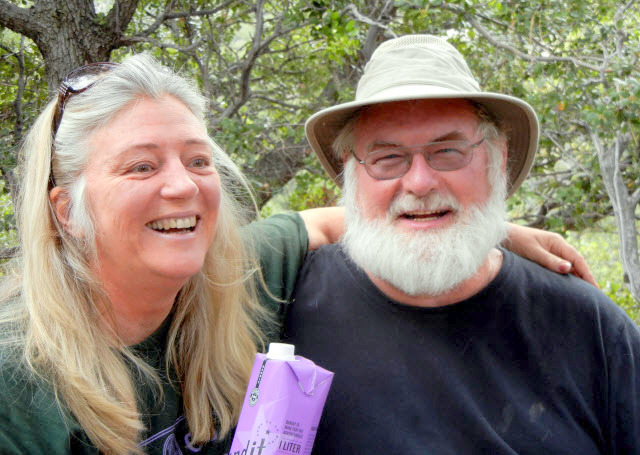
The rescue chopper, based in Apple Valley, Calif., responded immediately to the call. A sheriff’s deputy met Chris at the trailhead and he rode with them to the fire station where he pointed to our location on the map. In these circumstances San Bernardino County Sheriff’s dispatch two choppers, the first to identify the victim’s location and a second, heavier ship, to perform the air rescue. Deputy Doug Brimmer piloted the craft. He and Flight Officer Deputy Ryan Peppler were first to arrive in 40King6, a 2006 Eurocopter that scanned the canyon for almost an hour flying occasionally overhead.
They could not locate us easily in the brush, making many passes along the canyon in full view but too distant to signal. The pilot then asked via bull horn for us to wave something white. Sarah cleverly and enthusiastically waved her bra. I tied my bandanna to the walking stick and waved.
Once we were spotted, Deputy Brimmer radioed for Air Rescue 306, a Bell UH-1H chopper piloted by Deputy Dave Borgerd with Crew Chief Deputy John Scalise. On board were Fire Captain S. Simpson and Firefighter/Paramedic Eric Sherwin.
Sherwin was lowered and quickly extracted Sarah.
After they had carried Sarah to safety Sherwin walked to the spot above the tree when I sat and lowered a harness using the ropes I had rigged. I then scaled the distance I had fallen unassisted, finding a footing on the ridge.
Once I reached the ledge Sherwin brought the chopper in close and buckled the lifting hook into my waist harness. I was safely attached to the chopper and he was attempting to fasten a chest harness when the chopper suddenly rose a few feet, pulling me out of his reach and leaving me to ascend head down. I remember focusing on my boots as they hoisted me feet first. At first the rotors seemed a long way from those boots. The winch is mounted in the roof of the chopper and I recall thinking that suddenly those rotors were very, very close to my boots. They bent me in half and pulled me in feet first. The trip to Angeles Oaks took only a few minutes.
A KABC TV 7 reporter interviewed me on landing, the medics gave me a once over. I presented the containers of water to Sarah and got a big hug. The newspaper where I worked in the 1990s, the Riverside Press-Enterprise, ran a brief written by a reporter and friend of mine who coincidentally attended my 60th birthday party the previous Saturday. He didn’t know it was me.
It was about 5.5 hours after I fell before I landed.
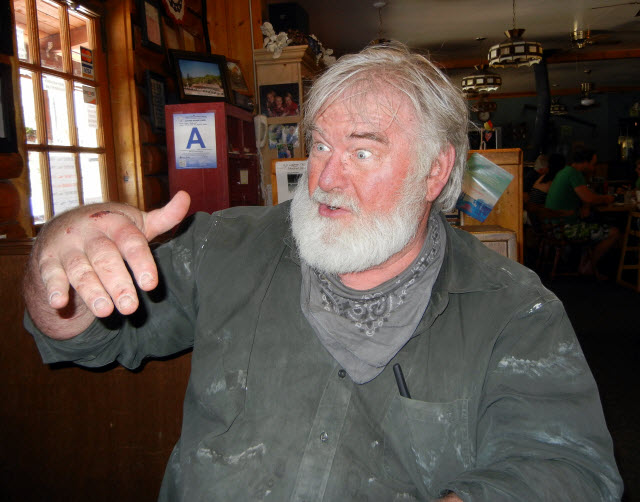
We rested at the Oaks Restaurant across from the fire station. The accompanying photo is me explaining the fall. As we walked into the restaurant the waitress said, “aren’t you the guy on TV we just watched them haul into the helicopter?”
“Yup. Burger and MGD please,” I replied.
That would have been the end of it except that all of our gear and my wallet, ID and passport were still on the mountain. One backpack had meat for dinner in bear country so we decided to climb right back up the mountain, spent an exhausted night and then climbed back down the next morning.
The second group of photos show Chris, Sarah and I celebrating the return to base camp with a box of wine.
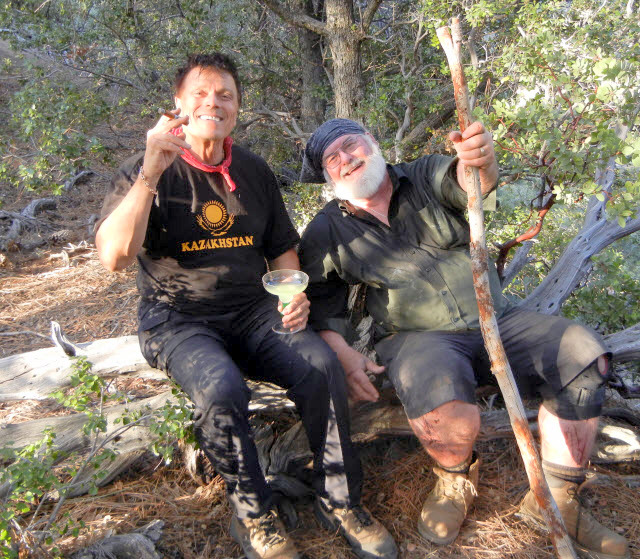
The campsite was a favorite of my now-grown children. I had ascended the mountain to bury a time capsule with items for my grandchildren (my first grandchild, Lux Alexander, was born to my son Patrick on Saturday, May 24, a couple of days before the hike).
The stainless thermos time capsule contains a computer SD chip with 592 ancestors in the family tree; a few trinkets prized by my two sons and daughter along with coins from 19 countries. A note encourages “the grandchildren whom I know and those I have yet to meet” to pick a coin and travel there as “adventure has so enriched my life.”
All is well… I live to write another tale. The TV reporter asked my advice for others: “Be Prepared” I said, recalling the Scout motto that served me well. The water filter and radio, the bandanna, the compass and knife all contributed to my return. Taking the time to rig that safety line made all the difference.
Hanging up there for several hours with a spectacular view I realized that if it turned out badly it would be a sad, but fitting end.
Propped against the cliff, hand throbbing, bloody legs straddling that tough little tree I sipped the cool mountain water that I had gathered, second-guessed some of my decisions and wondered when they would find me; why they didn’t answer my radio distress calls; how long the tree would continue to hold. I sat there examining one by one, the many facets of fear… calmly and without regret.
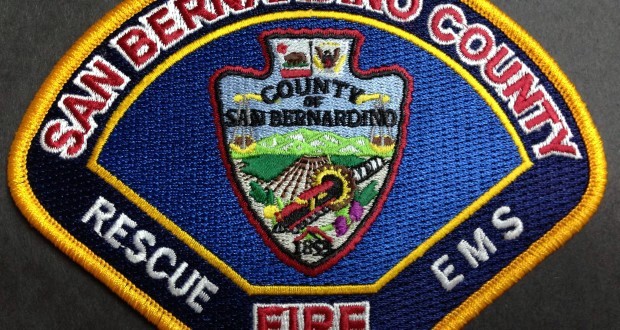 Dan is an Eagle Scout and former firefighter credited with saving the lives of others. He is very grateful to the San Bernardino sheriff’s deputies piloting the aircraft and the firefighters on board who saved his life.
Dan is an Eagle Scout and former firefighter credited with saving the lives of others. He is very grateful to the San Bernardino sheriff’s deputies piloting the aircraft and the firefighters on board who saved his life.



3 responses to “Helicopter Rescue”
Dan Just read this. I was fishing for fat browns in northern Adirondacks the last few days. The tea industry just breathed a sigh of relief and that includes me ! What an amazing story Graham
Sent from myphone
[…] in the beverage industry, he's probably in a forest cabin or a wilderness situation that could turn into an adventure. Now it's his turn to be on the other side of the interview. This isn't the first time […]
Dan! I know this happened a few months ago, but I just saw it now – so glad you’re OK, and that all turned out well in the end! I second Graham’s comment above about the tea industry breathing a sigh of relief, as well. Thank you for sharing this with us!